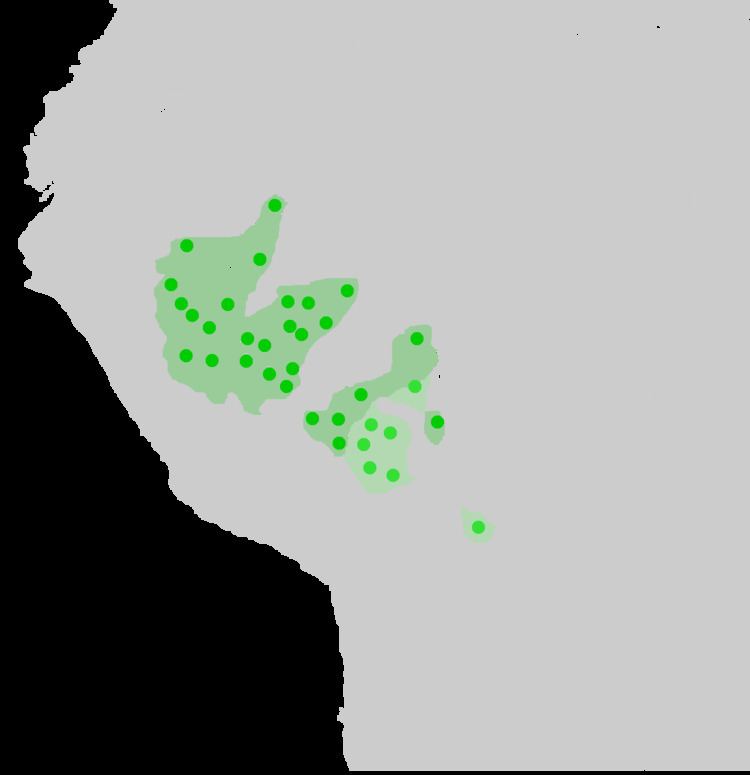Geographicdistribution southwestern Amazon Glottolog pano1256 | Linguistic classification Pano–Tacanan?Pánoan | |
 | ||
Panoan (also Pánoan, Panoano, Panoana, Páno) is a family of languages spoken in Peru, western Brazil, and Bolivia. It is a branch of the larger Pano–Tacanan family.
Contents
Languages
There are some 18 extant and 14 extinct Panoan languages. In the list, (†) means extinct, and (*) obsolescent (no longer spoken daily). Dialects are listed in parentheses.
Boundaries between the Poyanawa, Chama, and Headwaters groups are somewhat blurred. Karipuna and Môa River Nawa may not be distinct languages, and Chiriba may not be Panoan at all.
Hundreds of other Panoan "languages" have been reported in the literature. These are names of groups that may have been ethnically Panoan, but whose language is unattested. They sometimes are assumed to be Panoan on no other evidence than that the name ends in -nawa or -bo. A few, such as Maya (Pisabo), are unattested but reported to be mutually intelligible with a known Panoan language (in this case Matsés). The people speaking one of these supposed languages, Kontanawa, was rediscovered in 2002. However, no linguistic information is available, and it is not known if they speak a distinct language.
Homonyms
Much of the confusion surrounding Panoan languages is the number of homonyms among different languages. The principal ambiguous names are as follows:
Neighboring languages of other families may also share the names of Panoan language. The table below ignores other homonyms further afield:
Genetic relations
The Panoan family is generally believed to be related to the Tacanan family, forming with it Pano–Tacanan, though this has not yet been established (Loos 1999).
Body-part prefixation
Exceptional to Panoan languages’ predominantly suffixal morphology are sets of approximately 30 morphemes primarily referring to parts or features of prototypical human and animal bodies (and, by analogical extension, of botanicals, manufactures, landscapes, and abstract space) which have been found to occur in almost all attested languages of the family (Fleck 2006: 59; Ferreira 2007, 2008; Amarante Ribeiro and Cândido 2008; Zariquiey and Fleck 2012: 385–386).
That these monosyllabic forms are productively affixed to the front of verbal, nominal, or adjectival roots has led many Panoanists to describe them as prefixes (e.g. Prost 1967 and Zingg 1998 [for Chakobo]; Faust 1973, Loriot et al. 1993, and Valenzuela 2003 [for Shipibo-Konibo]; Hyde 1980 [for Amawaka]; Eakin 1991[for Yaminawa]), while the forms’ resemblance and loose semantic correspondence to unbound, polysyllabic ‘body-part terms’ has led others to describe them as incorporated nouns (e.g. Loos 1999). More recent and detailed analyses of this feature in Matses (Fleck 2006) and Kashibo-Kakataibo (Zariquiey and Fleck 2012) have demonstrated that most body-part prefixes in these languages are not readily analyzable as synchronic allomorphs of the nouns they resemble.
Many Panoan body-part prefixes semantically encompass a range of denotata beyond the strictly 'corporeal' by means of analogical extension. In Matses, for example, the prefix an- corresponds to the nouns ana ‘mouth, tongue, palm (of hand), sole (of foot), (arm)pit’; anmaëşh ‘gill slits (of fish)’; and anşhantuk ‘swampy depression in the ground’; but can itself be glossed also as ‘cavity, concave surface, interior, underside’; and ‘center (of path of stream)’ (Fleck 2006: 64). In the examples below, the prefix an- with the verb root kiad ‘learn’ expresses the learning of a specifically ‘oral activity’ while the prefix më- ‘hand, mortar, forearm, wrist, projecting carpal bones, elbow, finger, knuckles, fingernail, branch’ expresses the learning of a specifically ‘manual’ one:
The following example illustrates how an- can express locative information in non-corporeal, topographical space:
While body-part prefixes in Kashibo-Kakataibo, as in Matses, are highly productive with verbs, they are used regularly with only a modest array of adjectives and nouns (Fleck 2006: 72; Zariquiey and Fleck 2012: 394–5). Zariquiey and Fleck (2012: 394) note that the Kashibo-Kakataibo "words for 'skin', 'hair', and 'flesh'" are regularly prefixed:
Due to the paucity of detailed studies of Panoan body-part prefixes, explanations of their grammaticalization remain largely speculative. Fleck has hypothesized that "Panoan (verb) prefixation evolved from past noun incorporation that co-existed with noun-noun and noun-adjective compounding that involved synchronic reduction of body-part roots" (2006: 92). In light of their analysis of Kashibo-Kakataibo prefixation, Zariquiey and Fleck present two diachronic scenarios to orient future comparative work: "(1) prefixation evolved from productive noun incorporation (prefixes have come from longer body-part nouns); or (2) Proto-Panoan body-part terms were monosyllabic forms that became bound, and most of the current body-part terms were later built up from these" (2012: 408).
